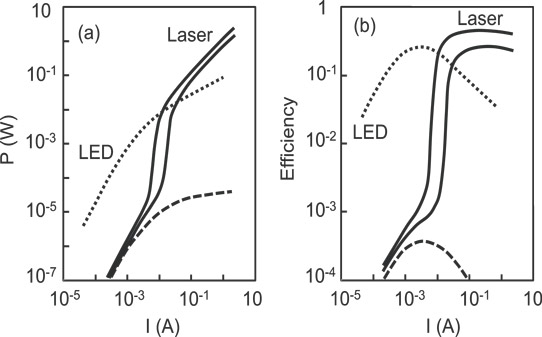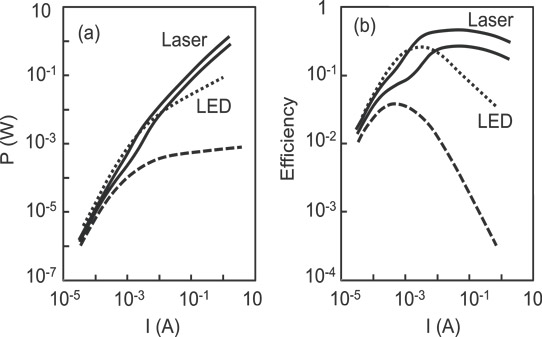- News
16 October 2015
Beating efficiency droop with III-nitride laser technology
Weng Chow and Mary Crawford of the USA's Sandia National Laboratories have been theoretically analyzing potential advantages and pitfalls in using lasers rather than light-emitting diodes (LEDs) as sources for white-light systems [W. W. Chow and M. H. Crawford, Appl. Phys. Lett., vol107, p141107, 2015].
Low-cost white LED-based systems tend to consist of a blue or ultraviolet indium gallium nitride (InGaN) LED combined with phosphors that produce the longer wavelengths needed to give a 'white' light effect on the eye.
Unfortunately, InGaN LEDs suffer from electrical and thermal efficiency droop effects at high current and junction temperature. The droop effect is associated with high carrier populations in the active light-emitting regions of such devices.
Recently, it has been suggested that InGaN laser diodes could avoid the efficiency problem above threshold where the carrier population is clamped to a relatively low level [see, e.g., Semiconductor Today, p76, July-August 2015; Mike Cooke, Semiconductor Today, p70, November 2013].
Chow and Crawford comment: "The extent to which efficiency droop can be solved by lasers depends on a complicated interplay involving non-radiative losses, stimulated emission, spontaneous emission, and intra-cavity absorption. An accurate quantitative evaluation should be performed before committing substantial resources towards laser-based lighting development."
First, the researchers compared models for an LED with a vertical-cavity surface-emitting laser (VCSEL), using a fully quantized approach for the behavior of electrons, holes, and photons. The active region consisted of a 2nm single quantum well of In0.37Ga0.63N in GaN barriers. The area of the LED was 100μmx100μm. The VCSEL was a 3x3 array with cells of area 5.6μmx5.6μm – a 3% fill factor compared with the LED area. The VCSELs used distributed Bragg reflectors (DBRs) as confinement. The VCSEL array properties were designed to give 1W power at 1A current.
The simulations show that with low absorption cavities one can expect improved power and efficiency above threshold over LED performance (Figure 1). However, the low efficiency below threshold could "limit the use of lasers in general lighting applications, e.g. where dimmable lights are advantageous for energy savings", according to Chow and Crawford.

Figure 1: (a) Output power and (b) efficiency versus injection current for LED (dotted curve) and array of nine VCSELs. Solid curves show cases where lasing threshold is reachable because of sufficiently low cavity loss (1/ps and 2/ps). Dashed curve is for high cavity loss of 4/ps, where lasing is not possible. Spontaneous emission factor is 0.01.
The researchers therefore suggest that nanolasers could be an alternative without the low efficiency at low current. Such devices use nano-scale resonant structures to channel spontaneous emission into lasing modes, giving more light below threshold. In 2012, there were reports of such devices operating at room temperature with optical pumping.

Figure 2: (a) Output power and (b) efficiency versus injection current for LED (dotted curve) and array of 144 nanolasers with spontaneous emission factor 1. Solid curves show cases where lasing threshold is reachable because of sufficiently low cavity loss (1/ps and 2/ps). Dashed curve is for 4/ps cavity loss.
Chow and Crawford's nanolaser simulation was for a 12x12 array with 560nmx560nm cells – a 0.5% fill factor compared with the VCSEL array. The nanolaser structure was based on a VCSEL with photonic lattice on the surface. The laser mode was from a defect site in the photonic lattice. Again, the aim was for 1W power at 1A current. The model gives similar performance to the LED below threshold and to the laser above threshold (Figure 2).
White LEDs LEDs InGaN VCSEL Efficiency droop
http://dx.doi.org/10.1063/1.4932582
The author Mike Cooke is a freelance technology journalist who has worked in the semiconductor and advanced technology sectors since 1997.


